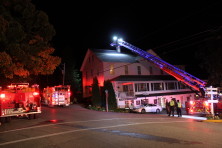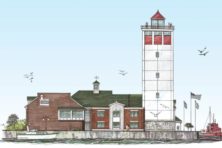News Bulletin: Sept. 27-Oct. 4
- Share
- Tweet
- Pin
- Share
WHAT HAPPENED
• The Sturgeon Bay School District Board of Education has approved a community-wide survey to gather stakeholder input before making decisions about potential facility improvements.
In July, the school board received a summary of findings of a recent assessment of all district facilities by Eppstein Uhen Architects and Miron Construction that indicates that although the district’s facilities are well maintained, many of the systems and components – such as mechanical and plumbing systems, windows and roofing – need replacement. These needs are greatest at the district’s oldest buildings, Sunrise and Sunset schools, which were built in the early 1950s.
The assessment also found that schools have available capacity but lack flexible and small-group learning spaces to support current and future programming for students at all grade levels. The full report is posted at sturbay.k12.wi.us, and a hard copy is available in the district office.
“District administrators and the Board of Education are committed to getting input and feedback from our stakeholders about the community’s priorities for our schools,” said Superintendent Dan Tjernagel. “To that end, we’ve partnered with School Perceptions to develop a community-wide survey that will be mailed to all households in the Sturgeon Bay School District in the next two to three weeks.”
Every household should receive a paper copy of the survey in the mail, and Spanish translation surveys will be available by calling the school district at 920.746.2807. The public is invited to hear the results of the survey at a special Board of Education learning session Nov. 5, 5 pm, in the Sturgeon Bay High School library.
• The Wisconsin Department of Natural Resources (DNR) reaffirmed its commitment to addressing the impacts of climate change on Wisconsin’s natural resources in a staff memo on Wednesday. In the memo, Secretary-designee Preston Cole outlined the department’s role in addressing climate change and clean energy through adaptation and mitigation.
“Climate change is one of the defining issues of our time,” Cole said. “From shifting weather patterns, increases in average temperature, higher frequency and intensity of rainfall to heavier snowfalls, the impacts of climate change directly impact Wisconsin. The DNR is entrusted to protect the people’s resources, and as a result, we need to recognize the factors that drive change and must plan accordingly.”
In August, Gov. Tony Evers signed Executive Order #38 to address the issue of clean energy in Wisconsin. Evers directed the Department of Administration to create an Office of Sustainability and Clean Energy that will coordinate with the DNR and others to develop and implement a clean-energy plan for Wisconsin.
The department also remains committed to the Wisconsin Initiative on Climate Change Impacts, which brings DNR experts and other agencies together with the knowledge and research of academia to assist decision-makers across the state. As the DNR carries out its work, the department will keep staff and the public informed and engaged with climate initiatives through new, easily accessible climate webpages that will be coming soon.
COMING UP
• October is Domestic Violence Awareness Month, and the community is encouraged to join HELP of Door County for the annual Walk With Me event Oct. 2, 4 pm, beginning in Sturgeon Bay’s Sawyer Park Pavilion. The short program will include special guest speaker Renee Bohm; HELP’s youth group, FYRE; and music by Jeannie Kuhns to remember victims of domestic violence in Door County and the 49 lives lost to domestic-violence homicides in Wisconsin in 2018. The walk will cross the Oregon Street Bridge, cross the Steel Bridge, move down 3rd Avenue and return to Martin Park. Refreshments will be provided. To learn more, call HELP of Door County at 920.743.8785.
• The Wisconsin Natural Resources Board (NRB) has directed the Department of Natural Resources (DNR) to expand public input about the DNR’s process for developing rules about the state’s water-quality standards. The effort is intended to decrease nitrate pollution in areas with highly permeable soils that are susceptible to groundwater contamination.
To achieve water-quality standards required by state statute, NR 151 establishes statewide runoff-pollution performance standards, prohibitions and practices for agricultural facilities. The rule also sets performance standards for nonagricultural and transportation facilities.
The NRB is asking that the public hearings relating to this process be expanded to three cities, including Fond du Lac, the Hancock Research Center and Janesville’s Blackhawk Technical College, and be held after Nov. 1.
By law, if the statewide performance standards and prohibitions do not achieve state water-quality standards, the DNR may develop targeted performance standards.
“This is a critical issue that needs a transparent, robust public input process,” said DNR Deputy Secretary Todd Ambs. “The research shows that 39 percent of Wisconsinites rely on private wells for their drinking water, and thousands of those wells have nitrate levels so high the water is unsafe. We must fix that.”
Following these three preliminary public hearings, the DNR will seek NRB approval of the scope statement, which allows the department to start a rulemaking process. The public can watch board meeting webcasts online, and after each meeting, the webcast will be permanently available on demand.


